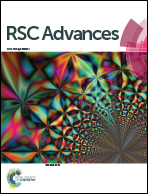Hexanuclear [Ni2Ln4] clusters exhibiting enhanced magnetocaloric effect and slow magnetic relaxation†
Abstract
Two hexanuclear 3d–4f cluster complexes containing the pyridine-2-aldoximate ligand (pao−), [Ni2Ln4 (hfac)8(pao)6(CH3COO)2(MeOH)]·H2O·MeOH (Ln = Gd, 1; Ln = Dy, 2; hfac− = hexafluoroacetylacetonate), have been synthesized, which show similar structures with an interesting ‘trigonal bipyramid’ metal topology. Magnetic determinations revealed that the Ni–Gd species has a spin ground state of 16 due to the dominant ferromagnetic exchange, exhibiting an enhanced magnetocaloric effect, which can be used as a cryogenic magnetic cooler; while the Ni–Dy analogue displays slow magnetic relaxation, a typical characteristic of a single-molecule magnet.
![Graphical abstract: Hexanuclear [Ni2Ln4] clusters exhibiting enhanced magnetocaloric effect and slow magnetic relaxation](/en/Image/Get?imageInfo.ImageType=GA&imageInfo.ImageIdentifier.ManuscriptID=C4RA07882A&imageInfo.ImageIdentifier.Year=2014)

 Please wait while we load your content...
Please wait while we load your content...